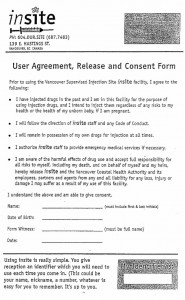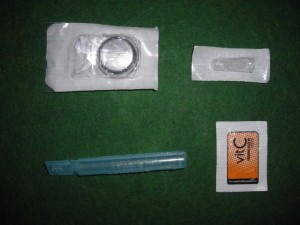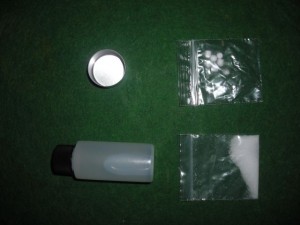On Tuesday September 16 from 9-10am immediately before opening I toured Insite’s facility in Vancouver. Insite is an organization which provides a location and equipment for persons wishing to inject themselves with illegal drugs such as heroin, cocaine, or methamphetamine. Insite philosophy incorporates harm reduction models with both humanitarian and economical objectives. Insite for Community Safety is a website associated with Portland Hotel Society (PHS; no website), which is a grassroots nonprofit community organization that manages InSite along with Vancouver Coastal Health (VCS), which is a governmental top-down organization that provides funding and legal infrastructure.
The way it works is that a person comes to the facility with their own drug. If it is this person’s first visit, the person registers as a client and chooses an anonymizing identifier, which acts as their personal password for access to services. The registration form is shown here;it may be hard to see that at the top right there is space for staff to collect gender and ethnicity info. After a person has registered once, then that person provides the identifier and the front desk logs the person’s visit and asks them what drug they are using. Then the person goes either to the injection room or, if there is no space, the waiting room.
The waiting room is just a quiet room with chairs, but it is separately walled from the reception, the injection room, and all other rooms. The injection room is a row of twelve one-person booths where a client can inject their stuff. The clients sit facing the wall, while two stations face them. At one station is a nurse and social worker who watch all the clients and who distribute gear, such as needles, cookers, filters, and other supplies necessary to use the drugs. At the other station is a relief nurse and social worker, who do other business without minding the clients too much, but are there if they are needed.
Thus far the rooms are in order and go deeper into the building; that is, the lobby looks onto the street, and the waiting room is behind the lobby, and the injection room is behind that. Now behind the injection room is a private chill area fitted with oxygen in case someone mildly overdoses and needs to breathe from a tank. Going left leads one on the way out of the site to a proper chill lounge, where people can sit and have free coffee, tea, or water and wait as long as they like. Usually people do not wait too long; passing the drink bar one exits back onto the street, having traveled in a U-shape through the building. But the wait room area also connects to some other rooms, like a medical exam room where abscesses or other health problems could be discussed privately, or to a social worker’s office where a client could talk to someone about accessing other services.
Insite works closely with other aid agencies and is able to make quick and efficient referrals. This is due to thorough collaboration that makes Insite aware of other agencies’ capabilities and the other agencies aware of Insite’s clients’ needs. Some of these other agencies (none of which seem to have websites) include the following:
- Community Transitional Care Team (CTCT) – an organization that provides long-term antibiotic care (e.g., for TB) to homeless persons, and is trained to work with injection drug users
- Pennsylvania Supported Suites (PSS) – a nonprofit organization based in the Pennsylvania Hotel nearby; this group provides long-term housing and assisted living facilities to persons with AIDS or other debilitating conditions
- Rainier Hotel – a 40 bed short-term housing facility for women that provides low-barrier intensive drug-use cessation treatment in 2-week treatment sessions
- Life Is Not Enough Society (LINES) – a vocational training an employment resource that is trained to work with injection drug users
- Onsite – a 30-bed detox housing facility located directly above Insite. This is a separate organization from Insite.
Also, I am sure that my guide Monica told me that Insite refers to inpatient and outpatient drug-cessation therapy, but I do not have notes on the names of the organizations providing those services. I do remember that they are separate agencies not managed by any of these other groups, though.
One final note I want to make is the difference in quality of injection supplies distributed by this place as compared to those dispensed in Seattle. In both of these pictures starting in the top right and going clockwise are the filters, acid, water, and cookers. In the top picture of the Vancouver equipment one can see that the filter is especially made for receiving a needle and pulling from a cooker, whereas Seattle just gives a cotton ball that is difficult to use and will also draw cotton fiber. Vancouver gives vitamin C packed by a group called Exchange Supplies whereas Seattle volunteers scoop citric acid and deliver it in a baggie. The safe injection site gives single-use sterile water ampules, whereas in Seattle the needle exchanges have people distribute plastic bottles that they fill with tap water. And the safe-injection site has disposable cookers with handles that have a rubber cover so that a user can hold them without burning fingers. As a person who does not inject drugs, it is not immediately obvious to me what a person has to do to use one of Seattle’s bottle-cap cookers, which have no handle and yet must be heated.
Insite is located at Hastings and Main in Vancouver, immediately north of Chinatown. The area is entirely urbanized and both Hastings and Main are major thoroughfares served by numerous bus routes. While this location itself is not a commercial center for high-end sales, it is within a few minutes walking distance of retailers whose business could be compromised if people did not feel safe walking to them. Insite serves 800 persons with injection facilitation every day, meeting a real community need.


